
Detail of the dolphin support on the card table illustrated in fig. 7. (Photo, Gavin Ashworth.)
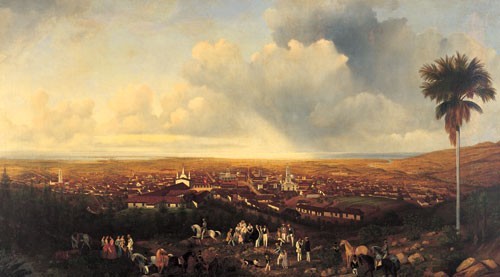
Eduardo La Plante (b. 1818), Trinidad visit general tomada desde la loma de La Vigia, 1852. Oil on canvas. 74 5/8" x 63 3/4". (Courtesy, Museo de Bellas Artes de Cuba, Havana.) This painting depicts Trinidad from the vantage point of La Vigia, a hilltop north of the town. Visible on the left side of the picture in the distance is the main road leading from Trinidad to Casilda, where cargo ships can be seen at anchor in the harbor.
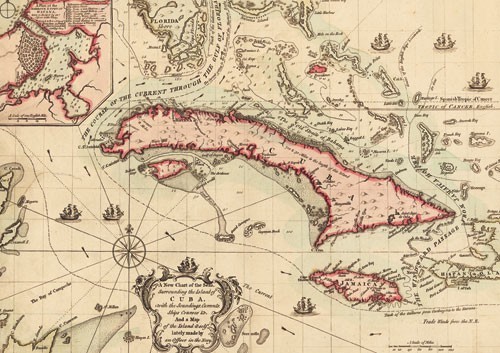
A New Chart of the Seas Surrounding the Island of Cuba, with the Soundings, Currents, Ships Courses &c. And a Map of the Island itself, lately made by an Officer in the Navy, illustrated in The London Magazine, 1762. (Courtesy, Map Division, New York Public Library.) Trinidad is located on Cuba’s south shore to the east of the Gulf of Jagua.
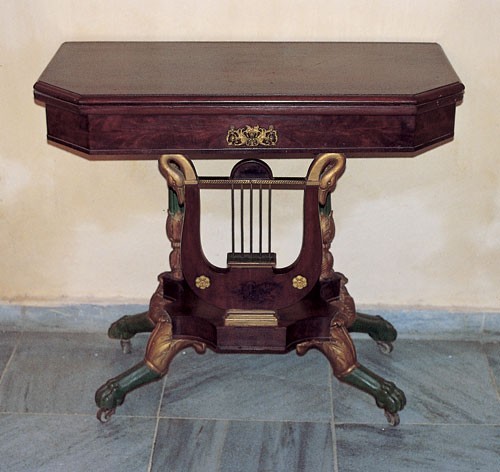
One of a pair of card tables attributed to Charles-Honoré Lannuier, New York City, possibly 1819. Mahogany and mahogany veneer with white pine; gilded gesso, vert antique, gilded cast brass, and die-stamped brass banding. Dimensions not recorded. (Courtesy, Museo de Artes Decorativas, Santa Clara, Cuba.) The upper leaf of the table is a replacement, and the die-stamped brass banding on the lower edge of the apron is missing. The ornament on the center of the apron matches one on the plinth of the card table illustrated in fig. 17. Visible on the base of the lyre is the shadow outline of an original cast brass gilded ornament, which was identical to that at the base of the lyre on the card table shown in fig. 15.
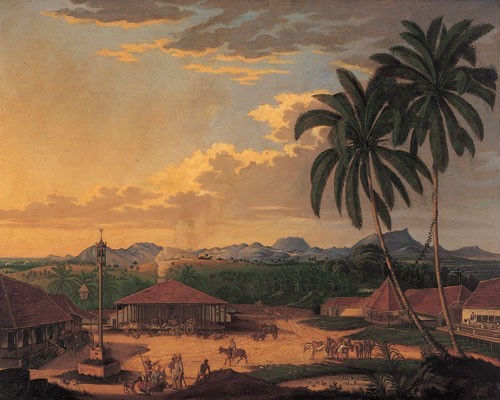
Emilio Piani (b. ca. 1812), Un Ingenio en Cuba, 1839. Oil on canvas. 29 3/8" x 36 3/8". (Courtesy, Museo de Bellas Artes de Cuba, Havana.) This picture depicts a typical nineteenth-century Cuban ingenio before the introduction of steam power mills. At the center of the picture is the mill and boiling house. Driven by oxen, the mill pressed the juice out of the freshly cut cane. The extracted juice was then boiled to produce syrup and poured into clay jars to dry. Holes in the bottoms of the jars allowed the darkest, thickest liquid (molasses) to settle while the remainder hardened into a sugar cone. Standing and lounging by a pile of firewood are criollo overseers or technicians and two slaves. The building to the left may be the home of the owner or the manager of the ingenio. Distant plumes of smoke on the left mark the sites of other ingenios.
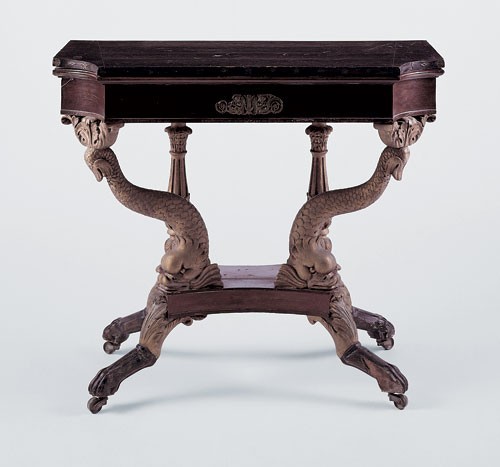
One of a pair of card tables attributed to Charles-Honoré Lannuier, New York City, possibly 1819. Mahogany and mahogany veneer with white pine, ash, and possibly basswood; gilded gesso, vert antique, gilded cast brass, and die-stamped brass banding. H. 30 3/4", W. 36", D. 17 7/8". (Chipstone Foundation; photo, Gavin Ashworth.) This table is shown after conservation in fig. 7, and its mate is illustrated in fig. 11.
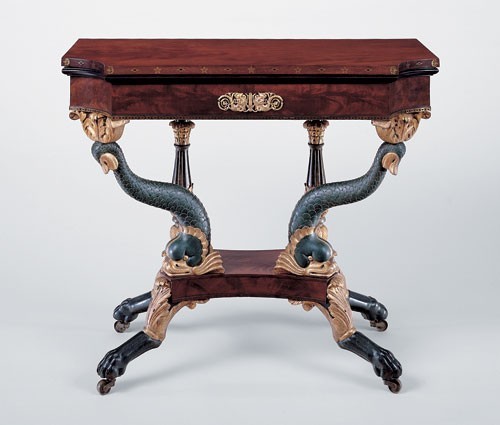
Post-conservation view of the card table illustrated in fig. 6. (Photo, Gavin Ashworth.) Conservation revealed the original decorative scheme of gilding and vert antique on the dolphins, rear columns, and feet. The fluted shafts of the back columns are a mottled yellow-green, which gives the effect of faux marbre or excavated, partially gilded, antique bronze. The bodies of the dolphins are painted a pure sea green with brightly burnished water-gilding on the head. The feet and acanthus corners are oil-gilded with a matte surface.
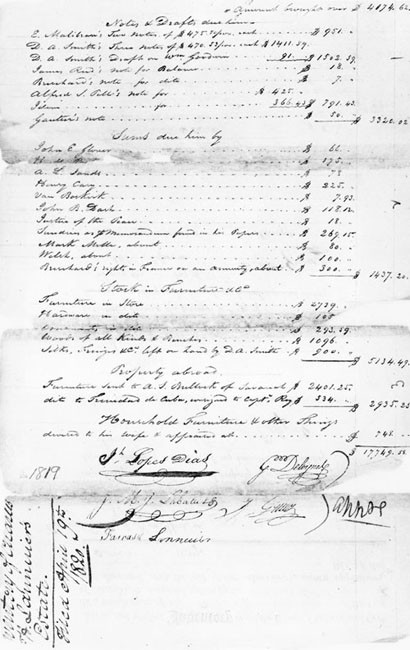
Detail from page 2 of the estate inventory of Charles-Honoré Lannuier, New York City, October 25, 1819. (Courtesy, Winterthur Museum Library, Joseph Downs Collection of Manuscripts and Printed Ephemera.)
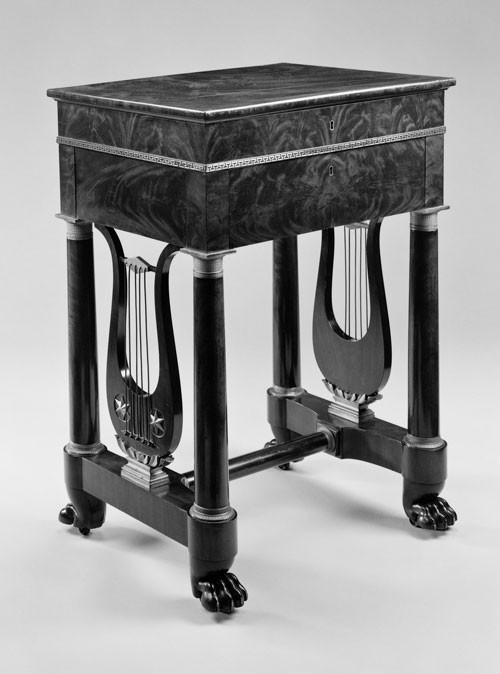
Charles-Honoré Lannuier worktable, New York City, 1817. Mahogany and mahogany veneer with white pine and yellow poplar; gilded gesso and vert antique, gilded cast brass, and die-stamped brass banding. H. 30 5/8", W. 22", D. 17 1/8". (Courtesy, Winterthur Museum; gift of Henry Francis du Pont.)
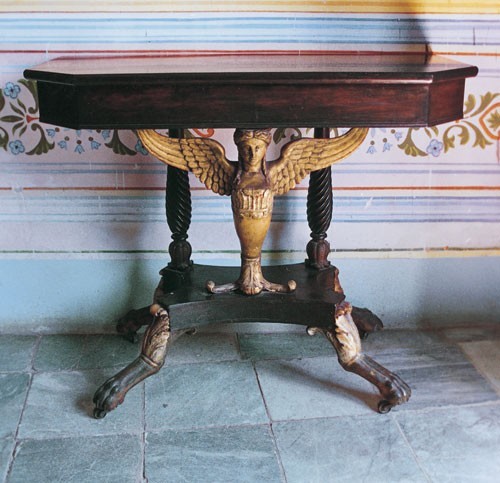
One of a pair of card tables attributed to Charles-Honoré Lannuier, New York City, possibly 1819. Mahogany and mahogany veneer with white pine; gilded gesso and vert antique. Dimensions not recorded. (Courtesy, Museo Romántico, Trinidad, Cuba.) The table originally had a hinged, two-part top that pivoted 90° and opened for use as a card table.
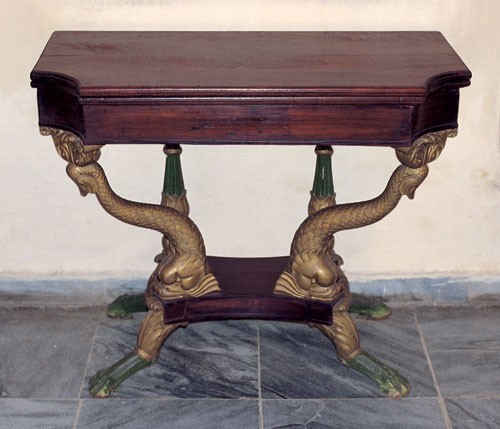
One of a pair of card tables attributed to Charles-Honoré Lannuier, New York City, possibly 1819. Mahogany and mahogany veneer with white pine and yellow poplar; gilded gesso and vert antique. Dimensions not recorded. (Courtesy, Museo de Artes Decorativas, Santa Clara, Cuba.) The original cast brass gilded ornament, die-stamped brass banding, and inlaid stars and anthemions on the lower edge of the apron and the front edge of the upper leaf are all missing (see fig. 7). The hinged top may be a replacement.
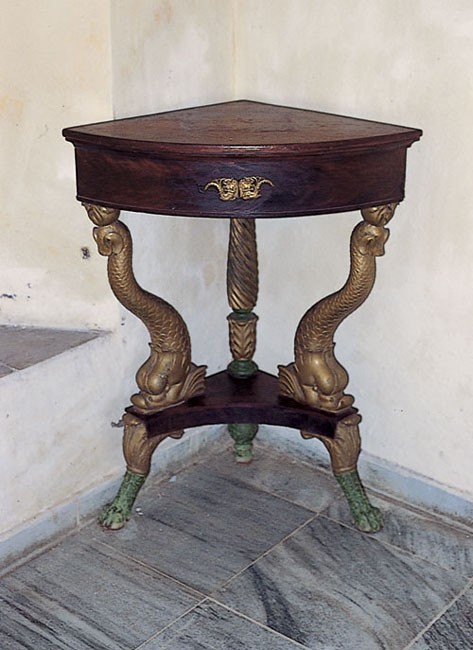
One of a pair of encoignures (corner tables) attributed to Charles-Honoré Lannuier, New York City, possibly 1819. Mahogany and mahogany veneer with white pine; gilded gesso, vert antique, gilded cast brass, and marble. Dimensions not recorded. (Courtesy, Museo de Artes Decorativas, Santa Clara, Cuba.) Originally this encoignure and its mate had marble tops, fragments of which are retained by the museum. The center ornament on the apron, which was identical to the one on the card table illustrated in fig. 7, has lost its outer terminating volutes. The lower edge of the apron most likely had the same lozenge-patterned, die-stamped brass banding as the card table.
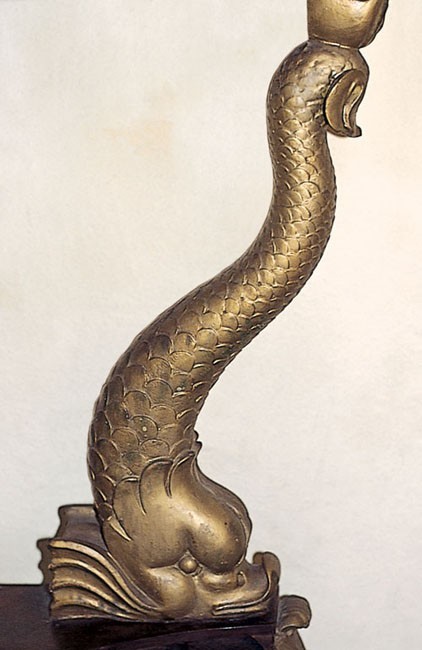
Detail of the dolphin support on the encoignure illustrated in fig. 12.
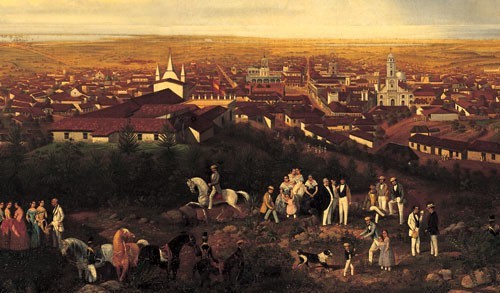
Detail of the painting illustrated in fig. 2 showing, in the center, the neoclassical mansion of Juan Guillaume Béquer with its prominent domed quinta, or tower. Visible immediately to the right is the two-storey rectangular quinta of another mansion in the Spanish colonial style. The latter residence belonged to Justo Cantero, Béquer’s rival in the sugar trade.
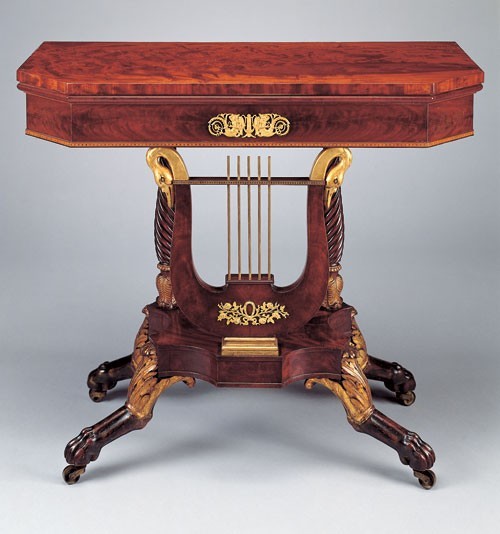
Card table attributed to Charles-Honoré Lannuier, New York City, 1815–1819. Mahogany and mahogany veneer with white pine, yellow poplar, and cherry or maple; gilded gesso, vert antique, gilded cast brass, and die-stamped brass banding. H. 31", W. 36", D. 17 7/8". (Private collection; photo, Bruce White.)
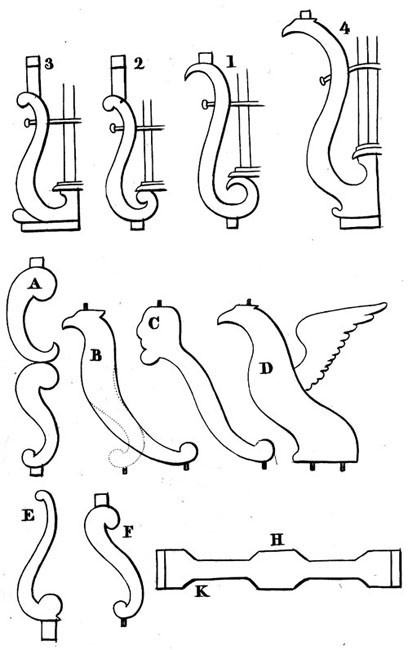
Plate 5 from The New-York Book of Prices for Manufacturing Cabinet and Chair Work, 1817. (Courtesy, New-York Historical Society.)
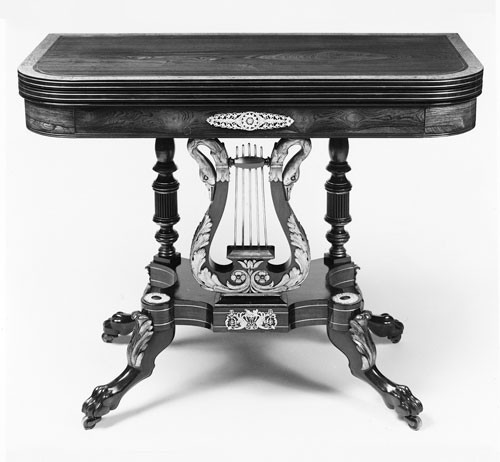
Card table, possibly by Duncan Phyfe, New York City, ca. 1820. Rosewood veneer with white pine and yellow poplar; gilded gesso, vert antique, gilded cast brass, and brass stringing. H. 30", W. 36", D. 18". (Courtesy, Hirschl & Adler Galleries, Inc.) The reeded drums on the back columns occur on furniture documented to Phyfe, and the carved feet are similar in design and workmanship to those on a card table with his label and the date 1820.
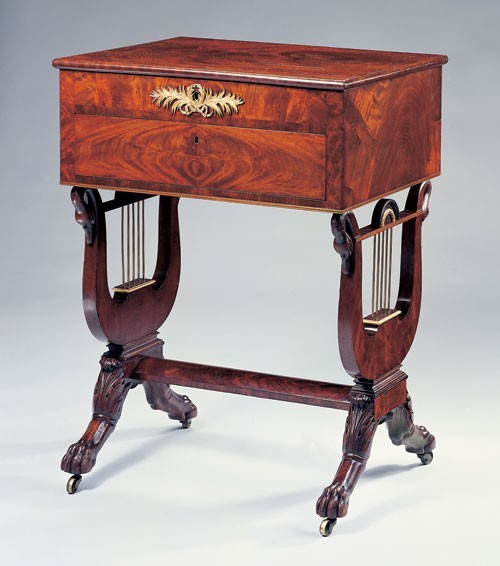
Worktable attributed to Charles-Honoré Lannuier, New York City, 1815–1819. Mahogany and mahogany veneer with white pine and yellow poplar; gilded cast brass and brass stringing. H. 32 1/4", W. 23 3/4", D. 17 5/8". (Private collection; photo, Bruce White.)
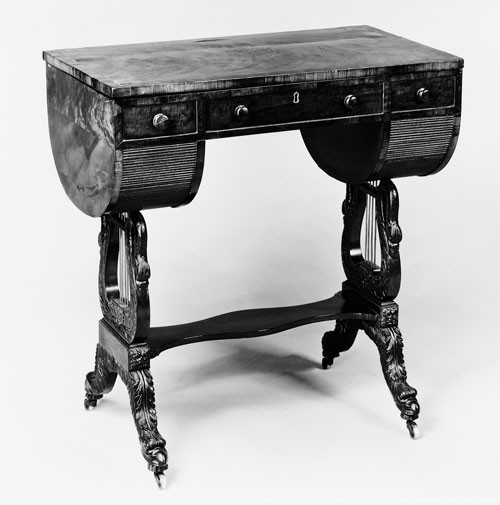
Michael Allison, worktable, New York City, 1823. Mahogany and mahogany veneer with yellow poplar. H. 29 3/4", W. 28 1/8", D. 15 1/2". (Courtesy, Metropolitan Museum of Art, Rogers Fund, 1933.)

Grecian sofa, New York City, ca. 1820. Mahogany and rosewood veneer with ash and maple or cherry; gilded gesso, vert antique, gilded stamped brass, and die-stamped brass. H. 34 1/2", W. 98 1/2", D. 27". (Courtesy, Metropolitan Museum of Art, Friends of the American Wing Fund, 1965.)
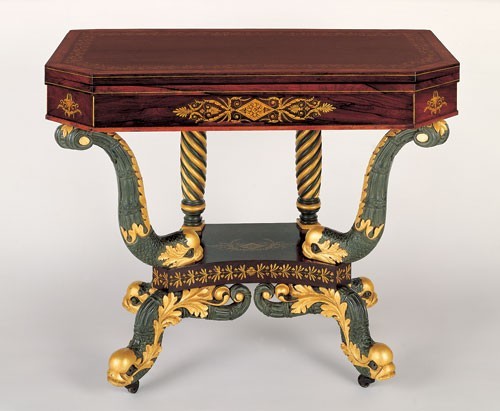
Card table attributed to Barzilla Deming and Erastus Bulkley, New York City, ca. 1825. Rosewood and satinwood veneer with white pine; gilded gesso and vert antique. H. 30", W. 37 1/8", D. 18 1/2". (Private collection; photo, Gavin Ashworth.)

Detail of a Grecian sofa, New York City, ca. 1820. (Courtesy, Hirschl & Adler Galleries, Inc.)
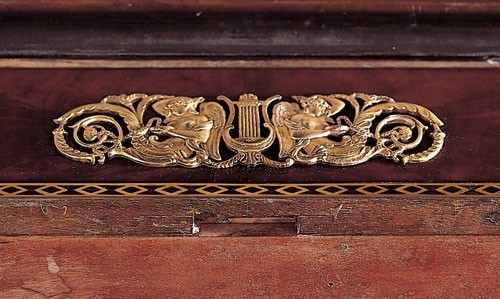
Detail of the bottom edge of the front apron on the card table illustrated in fig. 7 showing the unused rectangular mortise originally planned for a winged caryatid support. (Photo, Gavin Ashworth.)
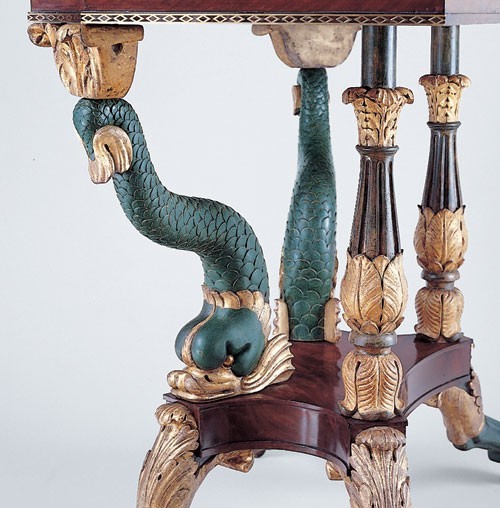
Detail of the card table illustrated in fig. 7 showing the way the dolphin’s body curves to the right as it extends to meet the incurvate corner of the table. (Photo, Gavin Ashworth.)
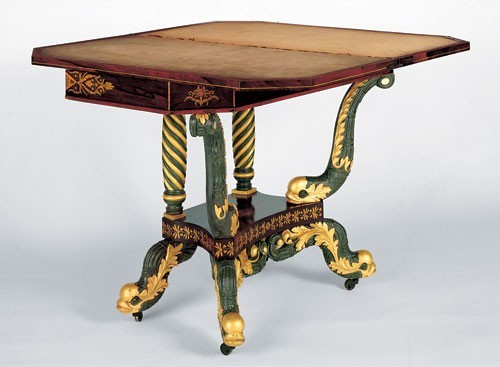
View of the card table illustrated in fig. 21 showing the straight bodies of the dolphins and canted volutes of their tails.
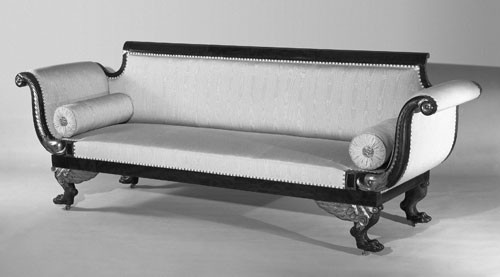
Grecian sofa, New York City, 1815–1820. Mahogany and mahogany veneer; gilded gesso, vert antique, and brass stringing. Dimensions not recorded. (Courtesy, Hirschl & Adler Galleries, Inc.)
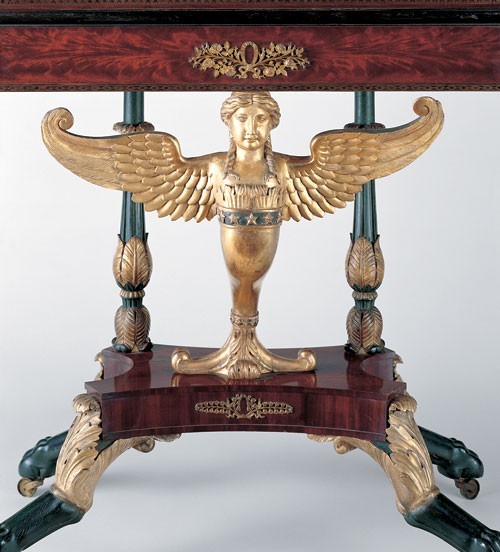
Detail of a caryatid support on a card table by Charles-Honoré Lannuier, New York City, 1817. Mahogany and mahogany veneer with white pine, yellow poplar, ash, and basswood; gilded gesso, vert antique, gilded cast brass, and die-stamped brass banding. H. 31 1/8", W. 36", D. 17 3/4". (Courtesy, Metropolitan Museum of Art, gift of Justine VR Milliken, 1995; photo, Bruce White.) This style of winged caryatid may be the earliest type produced in Lannuier’s shop. This table is one of a pair.

Detail of a caryatid support on a card table attributed to Charles-Honoré Lannuier, New York City, 1815–1819. (Private collection; photo, Gavin Ashworth.) This style of caryatid appears to be transitional. The original cast-brass gilded ornament and lower die-stamped brass border on the apron, which has been replaced by a flat strip of brass, are missing. The tips of the innermost seven feathers on the figure’s left wing are replacements. This table is one of a pair.
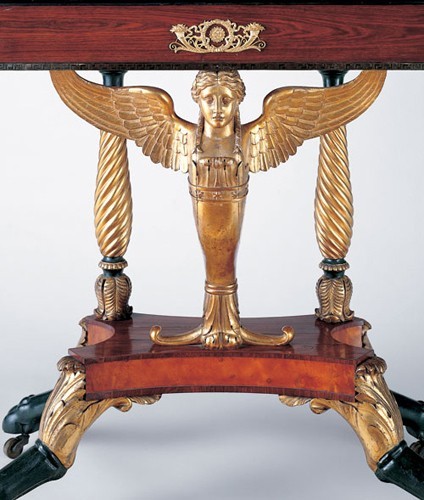
Detail of a caryatid support on a card table attributed to Charles-Honoré Lannuier, New York City, 1817. (Courtesy, Metropolitan Museum of Art, Funds from various donors, 1996; photo, Gavin Ashworth.) This style of winged caryatid appears to be the last produced in Lannuier’s shop.
Man here [New York City] is weighted down by his purse, not by his mind. . . . A fine painting or a marble statue is very rare in the houses of the rich of this city, and those individuals who would not pay fifty pounds for either, expend double that sum to vie with a neighbor in a piece of furniture.
—Mrs. Avery Jarvis to Samuel F. B. Morse, March 4, 1813
In the early nineteenth century, spurred by such publications as Charles Percier and Pierre-François-Léonard Fontaine’s Recueil de decorations intérieures (1812), Thomas Hope’s Household Furniture and Interior Decoration (1807), and George Smith’s Collection of Designs for Household Furniture and Interior Decoration (1808), style-conscious Americans and their avant-garde cabinetmakers increasingly embraced the sculptural forms of Paris and gilded ornament of the new, archaeological antique style. This style developed in New York between the War of 1812 and the Panic of 1819, America’s first economic depression. These years represent a high-water mark in the history of American neoclassical furniture design, when cabinetmakers Charles-Honoré Lannuier (1779–1819) and Duncan Phyfe (1768–1854) secured their reputations by providing patrons with the kind of richly ornamented furniture that Mrs. Jarvis felt had supplanted the fine arts in New York. Although Mrs. Jarvis may not have considered the winged caryatids, swans, mythical griffins, eagles, and lively dolphins (fig. 1) of the city’s furniture on a par with a “marble statue,” recent history has provided a different assessment, with major museums and collectors actively seeking these rare, sculptural objects.[1]
Eight figural tables recently discovered in Cuba expand and illuminate the work of Honoré Lannuier, New York’s finest practitioner of the French antique style. The probable dates of these objects suggest a chronology for the three different carving styles discernible in Lannuier’s card tables with winged caryatid supports. Just as rewarding and exciting, however, is the opportunity to reconcile this furniture with the historical record and consider the nature of society and culture at its destination, Trinidad de Cuba, where an elite group of traders and planters (fig. 2) ushered in a golden era of economic development in the early nineteenth century.[2]
An ancient town on Cuba’s south shore, Trinidad was one of the island’s original seven Spanish settlements founded in 1514 by Diego de Velázquez (fig. 3). When they arrived, the Spaniards witnessed the native Indians panning for gold in nearby rivers and quickly established a mine. It was not long until they discovered that the precious metal was in short supply. With its protected harbor at nearby Casilda, Trinidad proved a useful place for provisioning the Spanish military expeditions sent to Mexico to conquer the Aztec empire in 1518 and for supporting other maritime activities of the Spanish crown. Because of its relatively isolated position on the underbelly of Cuba distant from the Spanish colonial authorities in Havana, Trinidad early on developed a reputation as a haven for smugglers and pirates. During the late eighteenth and early nineteenth centuries it was human contraband that was smuggled ashore—enslaved Africans, many purchased in nearby British-controlled Jamaica, the epicenter of the Caribbean slave trade. These slaves formed the backbone of the Cuban sugar industry and provided the basis of wealth for Trinidad’s meteoric economic development in the early to mid-nineteenth century.
Cuba’s rise as an international leader in sugar production in the nineteenth century was inextricably linked to world events in the British- and French-controlled sugar islands of Jamaica and Santo Domingo. In Jamaica exploitative land use and the passing of British laws formally abolishing the slave trade in 1808 plunged the sugar industry into steep decline, while the first successful slave revolution in history in Saint Domingue (Haiti) left that island in shambles. Baron von Humboldt reported that there were 500,000 slaves and 31,000 French men and women in Saint Domingue when rebellion began in the 1790s. The inevitable toll of the revolution was the destruction of 180 sugar and 900 coffee plantations on the island and the deaths of thousands of slaves and whites.[3]
The slave revolt in Haiti led to a climate of fear and repression on many Cuban sugar cane plantations that lasted well into the nineteenth century. Juan Guillaume Béquer of Trinidad, who reputedly owned a pair of Lannuier card tables (fig. 4), narrowly escaped death in a slave uprising on his 1,200-acre sugar plantation, San José. English traveler David Turnbull’s account of injustices suffered by slaves in Cuba mentions Béquer, a transplanted Philadelphian named John William Baker who changed his name and became a naturalized Spanish citizen in 1819:
It is notorious to state that there are individual estates in the island with 600 or 700 negroes upon them, from which the softer sex is entirely excluded. In this respect I am bound to say that the Creole proprietors [persons of pure Spanish blood born in Cuba] evince much more regard for the laws of humanity than the emigrant planters from Spain and the United States. It is in fact but justice to others to signalise the case of a certain Mr. Baker, from the United States, who has established himself in the neighborhood of Cienfuegos on an estate where he has congregated no less than 700 male negroes, to the exclusion of a single female, locking up the men, during the short period allowed for needful rest, in a building called a barracoon, which is in fact, to all intents and purposes, a prison.[4]
The substantial wealth acquired by Cuban traders engaged in the slave trade was often used to purchase sugar plantations. As more land was acquired and put into production, additional slaves were needed to cut the cane and operate the mills, or ingenios as they are known in Cuba. It was an endless, exhausting cycle for both the land and the slaves. A model for this pattern of development in Trinidad is the Iznaga family, who accumulated a huge fortune from slaving in the eighteenth century and later invested the profits in nine famous sugar mills. The remnants of one of the Iznagas’ sugar plantations dating from the early 1800s, including some of the structures that formed part of the original batey, or complex of buildings essential to its operation (fig. 5), is today a prime tourist destination for visitors to Trinidad and its environs. According to tradition, the Iznagas of Trinidad were the owners of the suite, or partial suite, of tables with dolphin supports (figs. 6, 7, 11, 12).[5]
The Iznagas were envied for their power and wealth. Justo Germán Cantero, a penniless doctor from Santo Domingo, reportedly poisoned Pedro Iznaga and married his widow, who later conveniently disappeared, to get two sugar mills that belonged to his victim. The former doctor’s ambition and skill far exceeded that of other planters in Trinidad. Cantero purchased the latest steam-driven machinery and eventually wrote a major work on sugar production, titled Los Ingenios. A painting by Cuban artist Eduardo La Plante (see fig. 2) shows the doctor in the center of his family dressed in a stylish black frock coat overlooking his adopted town. With profits from his mills, Cantero built an elegant mansion commensurate with his decadent lifestyle. According to period accounts, his home contained a Roman marble bath and two cherub heads, one that dispensed gin for men and the other that dispensed eau de cologne for women. With a tower, or quinta, for viewing activity at the harbor, his residence rivaled that of the captain-general in Havana.[6]
The surviving Iznaga plantation is located in the Valle de los Ingenios, a fertile swath of land that knifes into the Sierra del Escambray range in a northeasterly direction from Trinidad. With rich soil and an abundant supply of trees to fuel the fires that burned constantly under the large cauldrons in which the sugar cane juice was refined, the valley was perfectly suited for the ingenios. The Valle de los Ingenios was also close to town and the harbor at Casilda, where slaves could be brought in and processed sugar and molasses could be shipped to the United States and Europe. Trinidad’s golden years in the sugar industry were relatively short, however, lasting from 1800 to the late 1850s. The decline was mainly attributable to the silt accumulation in the harbor at Casilda. After 1850 the deepwater port at Cienfuegos, eighty kilometers to the west, supplanted Trinidad as the leading entrepôt for sugar and molasses from inland plantations and foreign goods imported into Cuba’s south shore.
With the decline of the sugar trade, Trinidad entered a long somnolent period. A century later, President Fulgencio Batista referred to the town as a “jewel of colonial architecture,” and the national government passed laws to protect it from haphazard development. In 1965 Trinidad was declared a national monument, and thirteen years later UNESCO recognized it as a World Heritage Site. Beginning in the 1960s a group of local historians and preservationists began restoring the area around the central square, now known as the Plaza Mayor, but in the nineteenth century as the Plaza Serrano. Several of the important houses on the square were developed as museums, including the house of the Iznaga family (Museo Arquitectura) and the Palacio Brunet (Museo Romántico), an eighteenth-century Spanish colonial dwelling that was expanded and given a neoclassical facelift about 1815, just as the town was starting to prosper. The Palacio Brunet is furnished with objects appropriate to Trinidad’s golden era. Fine early-nineteenth-century French porcelains, Spanish colonial silver, English and American cut glass and gilt bronze lighting fixtures, and imported European and American furniture in neoclassical and rococo revival styles, all acquired from local families, offer a rich contextual setting that captures the once prosperous air of bygone times.[7]
Because of its waxing and waning economic cycle, long period of neglect, and subsequent preservation, Trinidad is a veritable time capsule for local material culture. Although patterns of consumption are readily discernible for the first half of the nineteenth century, many documents that might have identified American cabinetmakers who marketed their wares in Trinidad were destroyed when the Spanish colonial government’s records for the port at Casilda burned in a disastrous fire in 1964. Despite this loss, it is possible to reconstruct some of the circumstances surrounding Lannuier’s sales of furniture in Trinidad through other sources, including his estate inventory and the traditional histories of ownership assigned to the eight tables in Cuba.[8]
The Closure of Lannuier’s Furniture Manufactory and Warehouse
By the late summer of 1819 Honoré Lannuier’s health had declined to the point that he began preparing for death. In the September 2, 1819, issue of the New-York Gazette & General Advertiser he reported: “On account of ill health, he finds himself under the necessity of declining business altogether; for which reason he offers for sale, at very reduced prices, his entire STOCK of CABINET FURNITURE.” Just over six weeks later, at the age of forty, he was dead. His wife and close friends, the merchant Joseph Lopez Dias and mahogany dealer J.M.J. Labatut, served as the executors of the estate and did what they could to arrange his affairs and dissolve the business. Two sales of the contents of the shop ensued, the first in January 1820 and a final peremptory sale over a year later in May 1821.
According to Lannuier’s probate records, the value of furniture for sale in his Broad Street warehouse totaled $2,739 (fig. 8), which represents a significant but not enormous stock considering the amounts he charged for a range of forms in the years leading up to his death. In 1816 he billed Abraham Brinkerhoff $95 for a mahogany bedstead, $35 for a pedestal (probably a night table), and $135 for a dressing glass frame (probably a cheval glass). The following year he charged William Bayard $85 for the worktable illustrated in figure 9 and $250 for a top-of-the-line pair of gilded figural card tables identical to one shown in figure 27. The number of elaborate pieces Lannuier would have kept on hand is open to debate, however, owing to their high cost. More valuable than the furniture in the store was $2,935.25 listed under the heading “Property abroad”—$2,401.25 of custom work ordered by Archibald Stobo Bulloch of Savannah, Georgia, and $534 of stock sent to Trinidad de Cuba on board the ship of “Captain Roy.”[9]
The fact that the furniture consigned to Roy was at sea or had already arrived in Trinidad by the time of Lannuier’s death proves that the latter made the decision to send it there. The cabinetmaker’s inventory sale on September 2, 1819, may have failed to produce significant proceeds even at reduced prices. Through no fault of his own, Lannuier chose the worst possible time to liquidate his inventory. During the Panic of 1819, America’s first depression, sources of credit disappeared and hampered sales of furniture and other manufactured goods for master craftsmen through the mid-1820s. Hoping for greater sales opportunities in Cuba, Lannuier might have sent a selection of expensive pieces to Trinidad to entice wealthy grandees who had grown rich from sugar and the slave trade. The sheer number and value of the tables discovered in Trinidad strongly suggests that Lannuier had sent furniture there before. Six of the eight tables have carved and gilded sculptural supports and would have cost more than $700 collectively. This estimate is supported by Lannuier’s documented work for William Bayard in 1817, which included a pair of winged caryatid card tables that cost $250 and a pier table with gilded swan supports at the front corners that cost $300. The $534 value of the cargo sent on consignment to Trinidad with Captain Roy, therefore, was not sufficient for all of the tables with known histories in that town.[10]
Traditional Histories of Ownership in Trinidad
The eight tables with histories of ownership in Trinidad include three pairs of card tables and a pair of encoignures, or corner tables. Three different types of front supports are used on these tables, including Lannuier’s typical winged caryatids (fig. 10), mahogany-veneered lyres terminating in gilded swan heads (fig. 4), and dolphins with vert antique and gilded decoration (figs. 7, 11, 12, 13). Judging from complete suites of Lannuier furniture made for the Van Rensselaer and Campbell families of New York and the Bosley family of Baltimore, the matched card tables and encoignures with dolphin supports may have been accompanied by a marble-top pier table and possibly seating furniture.[11]
Although their early histories are obscure, all of the tables are associated with the Trinidad saccharocracy. Members of the Iznaga and Pomares families and Juan Guillaume Béquer are among the most likely candidates for being original owners. The Pomares were not as wealthy as many of their peers, but they were certainly cultured and capable of affording Lannuier’s finest work. José Felipe Pomares y González de Iglesia, who may have owned the tables with caryatid supports, was a successful businessman who was born in 1770 and married in 1798. According to accession records at the Museo de Artes Decorativas in Santa Clara, the lyre-base card table illustrated in figure 4 and its mate came from the house of Juan Guillaume Béquer, which was demolished in the early twentieth century. Given his American roots and lavish lifestyle, Béquer may have owned other Lannuier furniture including the partial dolphin suite. Museum records indicate that the matched tables belonged to Sánchez Iznaga of Trinidad, but at least two men with that name were in the town during the nineteenth century and either could have acquired the tables secondhand.[12]
Born about 1775, Béquer was the only son of Ann Marie Smyth and Jacob Baker, a Philadelphia merchant with business interests in the West Indies. An unsigned manuscript history in the Smyth family papers at the Historical Society of Pennsylvania indicates that John William went to Trinidad de Cuba in 1805 and never returned to Philadelphia. He did, however, maintain contact with his only sibling, Catherine Baker Comegys, for twenty years, sending her letters and cash totaling $1,500 to $2,000 per annum. Baker could easily afford to be generous, as he had become fabulously wealthy through the slave trade and his sugar plantations San José in Cienfuegos and Mainicú de Palmarejo in the Valle de los Ingenios. After receiving his naturalization letter as a Spanish citizen, in Havana, on July 15, 1819, he changed his name to Juan Guillaume Béquer. Béquer was a social striver who sought noble titles to legitimize himself in the eyes of the local criollo (Creole) planters. During his lifetime, Béquer received several titles including cavalier in the Order of Charles III and Isabel the Catholic, Gentil-Hombre of Her Majesty, and cavalier in the Order of Santiago. At the time of his death in 1860, his wealth was estimated to be $7,000,000. Béquer died intestate, and ten children from two different women, only one of whom he married legally, contested his estate. His marriage to Josefa-Eufemia Barceló occurred in articulus mortis, just moments after his death, when a local priest pronounced them man and wife and thus legitimized the three children she gave him.[13]
Befitting his elevated sense of importance, Béquer built himself a spectacular mansion in Trinidad on the southeast corner of the Plaza Serrano (now Mayor). His house is visible in the background of La Plante’s Trinidad visit general tomada desde la loma de La Vigia (fig. 14). In overall form the mansion is more reminiscent of a public building than a private home. The cupola-like quinta topped by a spire has an affinity to the one on the State House (Independence Hall) in Philadelphia, perhaps something Béquer had in mind when he built it. The mansion was reputedly built about 1825, which would reduce the chance he commissioned the Lannuier tables for that residence; however, the completion date is an estimate and Béquer could have begun building or planning his home several years earlier. Regardless of its initial use, Béquer’s Lannuier furniture was almost certainly among the original furnishings of his mansion.[14]
American travel writer Samuel Hazard observed that the dwellings on the best streets in Trinidad were “generally comfortable, well-built stone houses, some of which are really magnificent private edifices, as for instance, that of the Cantero family or the residence of Señor Bequer, nearly opposite the Plaza de Serrano.” Hazard further noted that Béquer’s mansion was “considered one of the finest in the island.” The latter’s extravagance apparently knew no limits. Béquer once reportedly proposed to lay a mosaic of doubloons in the floor of his dining room. When the authorities told him that it would be improper to walk on the Spanish coat of arms, he suggested, in an “act of loyal extravagance,” that the coins might go on their edges.[15]
Visitors to Béquer’s mansion entered a grand hall that offered a view to the top of the domed quinta. Stairs to the right and left of the hall ascended to the second floor, and two sets of winding, cast-iron stairs rose from the second floor to the top of the tower. Painted white and gold with sky blue on the backsides and undersides, the cast stairs had pierced risers and treads, classical candelabra-form balusters, acanthus-scrolled spandrels, and Grecian palmettes on the supporting columns. Both sets of stairs were removed from the house when the upper storey and tower were demolished. They were subsequently installed in the Cathedral Santisima Trinidad on the north end of Plaza Mayor, where they serve as the stairs to a matching pair of pulpits. The interior of the cathedral was rebuilt in 1894, which may provide a possible date for the alterations of the Béquer mansion. Hazard illustrated a view of the back of the mansion in 1871 with its second storey and quinta intact. This image shows a large gallery across the back of the house on the second floor and a balustraded flat roof, which could be gained from the base of the quinta. Surviving views of the house indicate that it was a five-bay structure, one room deep, with a wide, two-storey, projecting block at the back. The open entry hall suggests a symmetrical room arrangement, with a large central hall flanked by a parlor and dining room on the first floor, and a similar arrangement on the second floor with the rooms on either side of the upstairs hall perhaps partitioned into bedrooms and sitting rooms or dressing rooms. A large colonnaded, two-storey front porch extended across the entire width of the mansion. The entry and second-floor halls may also have served as living spaces, cooled in the humid Cuban summer by cross breezes from the front and back porches and the chimneylike ventilating effect of the quinta. Handsome original neoclassical wrought-iron window grilles survive on the front of the house facing the square, though the front porch is now entirely gone. Future research into existing Philadelphia ironwork may reveal that both the grilles and cast-iron stairs in the entry hall were manufactured there.[16]
The Cuba Tables in Context: Comparisons with Known Works
Béquer’s lyre-base tables (see fig. 4) are similar to three others, one in the Governor’s Mansion in Austin, Texas, a second in a private collection (fig. 15), and a third illustrated in Lewis F. Hinckley’s Directory of Antique Furniture. All have supports based on the table illustrated in plate 5, no. 4 of The New-York Book of Prices for Manufacturing Cabinet and Chair Work (fig. 16). On the Lannuier examples the bridge holding the strings is straight rather than curved, longer, and decorated with the cabinetmaker’s characteristic die-stamped brass banding. The upper ends of the lyres terminate in gilded swan heads tucked coyly down against their breasts instead of jutting out in the form of an eagle’s head with a pointed beak as in the published design. The inspiration for the swan heads may be plates 6 and 17 in Percier and Fontaine’s Recueil, which depict two different basin stands with this type of support. The use of sophisticated Gallic details was a hallmark of Lannuier’s work, especially during the last five years of his career. A similar tilt toward French design is apparent in another lyre-base card table possibly from the shop of Duncan Phyfe (fig. 17), although this example appears derivative in the shaping of its hocked lion’s-paw legs.[17]
Two additional features distinguish Béquer’s tables from the other three Lannuier examples. The rear supports are shaped like antique candelabra rather than an inverted lotus bud surmounted by a twisted baluster. Lannuier tables with winged caryatids often have candelabra supports in the back; however, two pairs with lotus bud and baluster variations are known (see figs. 10, 29). The tables from Trinidad de Cuba also differ from the related lyre-base forms in having an applied demilune on the bridge above the brass strings. This distinctive feature appears on a worktable with lyre and swan supports that would have perfectly matched this model card table in a parlor suite (fig. 18). Lannuier’s continuing influence on other New York cabinetmakers, even after his death, is manifest in a labeled and dated worktable by Michael Allison (1773–1855) (fig. 19).
The matched pairs of card tables and encoignures are novel in the French cabinetmaker’s repertoire of sculptural forms. Although carved dolphins occur on other Lannuier pieces, they invariably serve as feet. The larger dolphins on the Trinidad tables have bulbous heads and beadlike eyes identical to their more subordinate counterparts, but their elongated bodies are covered in scales. This more naturalistic treatment has parallels in several richly ornamented Grecian sofas (fig. 20) and a group of card tables, some of which are attributed to the cabinetmaking partnership of Barzilia Deming and Erastus Bulkley, who marketed their furniture extensively in Charleston, South Carolina, beginning about 1818 or 1819 (fig. 21).[18]
Americans’ interest in dolphin furniture is typically associated with English rather than French influence, more specifically with Viscount Horatio Nelson’s (1758–1805) spectacular victory over the French at Trafalgar. In memory of Nelson, who died in that battle, an elaborate suite of gilded and brass-inlaid furniture with sculptural dolphin supports was presented to Greenwich Hospital in 1813 and 1815, and is now displayed at Brighton Pavilion. Another nautical motif that became popular in the wake of Nelson’s triumph is twisted cable or rope turning like that on the rear supports of the card table illustrated in figure 29.[19]
Classical mythology provided the basis for the use of dolphins on furniture made in memory of the departed naval hero. In Greek art, dolphins are often depicted with men on their backs, transporting departed souls to their homes beyond the tomb. Dolphins were also associated with regeneration. According to an interpretation of one Greek legend:
Dionysus had hired a boat to take him to Naxos, when he noticed that the crew was steering towards Asia, undoubtedly to sell him into slavery. Thereupon, he transformed their oars into serpents, filled their ship with ivy and caused the music of invisible flutes to be played. . . . the sailors went mad, jumped overboard and were turned into dolphins. This explains why dolphins are friends to humans and try to save them from shipwreck—they are reformed pirates.
If American consumers considered dolphins maritime talismans, it might explain why Deming and Bulkley’s card tables found a receptive market in Charleston and why sofas like the one illustrated in figure 20 appealed to New Yorkers. Both ports had an abundance of wealthy patrons who profited from seafaring activities and were schooled in the myths of ancient Greece.[20]
A less benign sea creature appears on several other New York sofas (fig. 22). In Greek mythology monsters with serpentlike bodies, upturned snouts, and sharp teeth are known as keti. The ketos is most familiar in the myth of Perseus and Andromeda. After slaying the Gorgon Medusa, Perseus saved the beautiful Andromeda, who was bound to a rock in a raging sea and about to be devoured by a ketos. According to legend, the couple subsequently fell in love, married, and lived happily in Argos. As symbols of this myth, keti conjured images of the heroic male and helpless female—concepts that resonated in patriarchal societies and households. This motif may also have played on the human fear and fascination with the deep, just as certain horror movies do today.[21]
In Lannuier’s work, dolphin supports are found only on the pairs of card tables and encoignures from Trinidad. It is tempting to postulate, though difficult to prove, that he began to use dolphins on sculptural table forms at a relatively late date in response to the popularity of this motif on New York sofas made by other New York cabinetmakers and upholsterers. The presence of an open mortise centered on the underside of the apron on the card table illustrated in figure 23 indicates that the upper frame was originally prepared for the more common type of figural card table with a single winged caryatid at the front (see figs. 27–29). This bit of evidence suggests that the Trinidad tables may have been Lannuier’s first experiment with the dolphin design. There is no doubt that the dolphin supports were specifically made for the card tables, as their tails have compound curves that flow to the incurvate corners in a graceful, naturalistic manner (fig. 24). Only a few carved and gilded acanthus leaves and volutes were required to form the connection to the upper frame. Lannuier’s design was extremely successful in balancing the mass and scale of these painted and gilded supports with the rear columns and front legs.
On Deming and Bulkley card tables, the dolphin supports do not have compound curves. Instead, their straight bodies extend all the way to the corners of the frame and terminate in eccentric volutes angled to match the corner cants (fig. 25). Further comparison with Deming and Bulkley tables reveals that the artisans in their shop consistently positioned the dolphins facing inward, an orientation also found on another type of New York Grecian sofa with dolphins (fig. 26). On the sofas this placement is logical because the dolphins follow the flow of the fulcrumlike arms. On the card tables, however, the confronting supports are at odds with the dolphin feet, which appear to be swimming in opposite directions. In Lannuier’s composition (see fig. 7) the outward-facing dolphins visually transfer the weight of the upper frame and top downward to the plinth, and the hocked lion’s-paw feet bend gracefully in response. Given the disparity between the two approaches, it would be difficult to say that Lannuier influenced Deming and Bulkley or vice versa.[22]
Investigation into the painted and gilded treatment of the dolphins on the Lannuier card table illustrated in figure 6 has revealed that the original materials and techniques used are compatible with the refined work that was coming from his shop in the late 1810s. Microscopy, pigment analysis, and the removal of multiple layers of later surface coatings were included in a major conservation effort that preserved the table and achieved an overall appearance consistent with the maker’s intent (see figs. 1, 7). The dolphins on the remaining card table and pair of encoignures in Cuba have not undergone scientific testing, but later coats of gold-toned paint appear to protect the original surface as they did on the recently conserved example. In Cuba, historic objects with water-gilded surfaces were often painted to protect them from the island’s high relative humidity, which is especially detrimental to water-gilding. Wood-eating insects have also been a factor in the survival of furniture imported into Cuba. The white pine and ash secondary woods of the table illustrated in figure 6 were so thoroughly infested that the X-shaped cross members inside the plinth were mere shells of their original form. Only a very determined and foolhardy patron who did not care about the long-term survival of his furniture or a dying cabinetmaker desperate to recoup some capital on his investment in time and materials would consider placing such delicate work in this semitropical environment.[23]
An inhospitable climate and the vagaries of time have also damaged the pair of winged caryatid card tables in Cuba (see fig. 10). Although the tables have lost their original gaming function and now serve only as consoles with modern fixed-board tops, they are among twenty-one (including nine pairs) winged caryatid examples from the shop of New York’s resident ébéniste de Paris. Neither of the Cuban tables has brass stringing or die-stamped brass banding on the lower edge of its frames or cast gilt-brass ornaments on the center of the front apron and canted corners. No shadows or pinholes for attachment are visible, but such evidence could be obscured by the thick coat of opaque varnish subsequently applied to all the veneered surfaces. The winged caryatids and hocked lion’s-paw feet appear to have been regessoed and gilded and varnished in modern times. The gilding is very thin, the white gesso shows through in several areas, and there is no evidence of a bole layer between them. Typically available in yellow, red, blue, and charcoal gray, bole influenced the color and tone of the leaf applied over it. Bole was a prerequisite if the gilding was to be burnished. The rope-twist back columns may have been vert antique with oil-gilding on the inverted lotus buds at their bases, but their original surface treatment has been obscured by varnish.
Another pair of Lannuier card tables with caryatids, rope-twist back columns, and hocked lion’s-paw feet identical to those on the Cuban examples are known (fig. 29). Before the former tables were discovered, the latter were considered anomalous within the larger group. One significant difference between the related pairs, however, is the canted versus incurvate corners. The combination of canted corners and the visually animated hocked legs on the Cuban tables makes them unique. Three pairs of card tables and a single example from Lannuier’s shop have canted corners, but their lion feet are heavier with downward-pointed acanthus leaves on top (fig. 28). The Cuban tables’ deviation from the standard might represent creative experimentation, but it could also indicate that the artisans in Lannuier’s shop used prefabricated parts in an atypical combination to expedite their sale at the shop closeout or for shipment with Captain Roy.[24]
If the card table illustrated in figure 10 and its mate were among the furniture Lannuier sent to Trinidad de Cuba in the late summer or early fall of 1819, an end date of manufacture can be tentatively established for tables with their particular style of winged caryatid. Based on this evidence and documentation surrounding two other pairs of tables, a design chronology for the three variations of winged caryatids that appear in Lannuier’s signature series of card tables can be proposed. All twenty-one tables are thought to have been made between about 1815 and 1819. Thirteen have Lannuier’s third and most elaborate engraved trade label, or evidence of the same, on the undersides of their wells or plinths. One table is not labeled, but it has the maker’s initials and the place and date of manufacture written in French on a brace: “Fait a New-York / Le I May 1817 / HL.” Seven tables, including those shown in figures 10 and 29, have neither labels nor any other evidence of authorship except for their obvious relationship to Lannuier’s documented work. Therefore, the most important tables in establishing a design chronology are the initialed and dated ones originally owned by Stephen Van Rensselaer IV of Albany and the pair in Cuba.
The winged caryatid on the table dated 1817 (fig. 27) is the most common of the three styles and appears on fourteen other examples of this form. It is also the boldest design, meant to attract attention from across the room. The shoulders are broad and nearly at right angles to the neck, while the wings—set in a flat plane and pitched slightly forward—spread wide and float freely in the space between the apron and plinth. Consistent with contemporary French work, the figure was carved in basswood, coated with gesso, and recut for greater detail. The recutting is more extensive than on other caryatids attributed to Lannuier’s shop.
If winged caryatids like the one on the Van Rensselaer table are the earliest documented examples from Lannuier’s shop and those on the tables in Cuba date from the end of his career, it is logical to assume that figural supports sharing features with those at either end of the spectrum are intermediary. The early and transitional caryatids (figs. 27, 28) are carved from basswood and have slightly heavier coatings of gesso than the later figures. The bases of their bodies are narrow and ringed by identical bands of tiny rosettes, whereas the caryatids presumably dating from the end of Lannuier’s career have thicker bases, ringed by double reeds (fig. 29). The “flippers” on either side of the narrow-based figures curve tightly upward, abut the body at the base, and are held in place with tiny loose tenons. On the later caryatids, the flippers and upturned acanthus leaves at the front are cut from a single piece of horizontally oriented wood that receives a tenon connecting it to the body. The latter method of construction is superior, as indicated by the frequent loss of original flippers on the earlier-style figures.
The transitional and later caryatids (figs. 28, 29) are more similar in general outline. Their wings are slightly cupped and clipped off where their tops engage the upper table frame. To accommodate the tips of the wings on the intermediary figures, the workmen in Lannuier’s shop cut small reserves in the bottom of the well and lower edge of the front apron. On the figures presumably dating from the end of his career, the wings fit flush against the bottom boards of the well—a more refined technique than that used on the earlier examples. In some respects, the design of the transitional and later caryatids appears to be a reaction to the brashness of the earlier figures. The wings on the former are reduced in scale and their inner feathers have rounded tips and a prominent ridge running up the center. In contrast, the feathers on the earlier tables are slightly pointed like those on the Van Rensselaer example (see fig. 27). If the proposed chronology is correct, the artisans in Lannuier’s shop moved away from recutting gesso and did much more detail work in the wood. Two marble-top pier tables and a center table have caryatid figures carved in mahogany—a hardwood that typically allows for crisper cuts than basswood.[25]
The carving and gilding of sculptural figures often required the talents and collaboration of several tradesmen. According to Thomas Sheraton’s Cabinet Dictionary (1803), large shops typically employed three types of carvers in the production of sculptural work. “Boasters” glued up stock and used saws and gouges to establish the rough outline; specialist carvers “applied the finshing strokes” in the wood; and gilders applied and recut the gesso. “In small factories,” Sheraton noted, “it is common for one carver to begin and finish the whole of the carving. But where there are a number of hands employed and in pieces that require much skill, the other is the most preferable way.” Although no documents regarding the size and composition of Lannuier’s workforce are known, the sophistication and complexity of his surviving furniture suggest the involvement of specialists with diverse talents.[26]
The fact that Lannuier sent furniture to Trinidad de Cuba is hardly startling since we know from his estate inventory that he consigned furniture to Captain Roy in the final months of his life. The discovery of much or all of this consignment, and probably more, in its original destination nearly two centuries later is miraculous. Additional investigation and research in Cuba will undoubtedly lead to the discovery and documentation of more American furniture sent there in the nineteenth century, when sugar was king and United States involvement was growing in intensity. It can only be hoped that these discoveries will be as exciting, enlightening, and visually satisfying as the Lannuier tables in Trinidad.
ACKNOWLEDGMENTS
For their assistance with this article, the author thanks Cecilia Bermudez, Elaine Bradson, Andrew Brunk, Giovanni Bucchi, Ruth Claxton, Peter Fodera, John Hays, Claire Kenny, W. David Knox II, Jeanne Ko, Esther Morales, Kenneth Needleman, Dr. Victor Pina, Dr. Leyda Quintana, Isabel Rueda Rodriguez, Yelene Rodriguez, Jeff Rosenheim, Suzanne Rubin Schein, Olaf Unsoeld, Cornelius Van Horne, Dr. José Viera, Julio Viera, Carlos J. Zerquera, and Rafael Zerquera.
Mrs. Avery Jarvis, Blomingdale, New York City, to Samuel F. B. Morse, March 14, 1813, as quoted in E. McSherry Fowble, “Without a Blush: The Movement toward Acceptance of the Nude as an Art Form in America, 1800–1825,” Winterthur Portfolio 9 (1974): 121. Fowble mistakenly cited Morse as the author of the letter. For the accurate reference, see Samuel F. B. Morse: His Letters and His Journals, edited by Edward Lind Morse, 2 vols. (New York: Houghton Mifflin Co., 1914), 1: 101. Charles Percier, Pierre-François-Léonard Fontaine, Recueil de decorations intérieures comprenant tout ce qui a rapport à l’ameublement, comme vases. . . . (Paris, 1812). Thomas Hope, Household Furniture and Interior Decoration (London, 1807). George Smith, A Collection of Designs for Household Furniture and Interior Decoration (London, 1808).
The author thanks Walter Richard Wheeler for calling his attention to Andrea Black’s Living in Cuba (New York: St. Martin’s Press, 1998), which illustrates the dolphin card table illustrated in fig. 10 (p. 114) and one of the winged caryatid card tables at the Museo Romántico (p. 128).
Hugh Thomas, Cuba: The Pursuit of Freedom (New York: Da Capo Press, 1998), pp. 119, 140.
David Turnbull, Travels in the West, Cuba with Notices of Porto Rico, and the Slave Trade (London: Longman, Orme, Brown, Green and Longmans, 1840), p. 146.
Thomas, Cuba, p. 83. Christie’s, Important American Furniture, Silver, Prints, Folk Art and Decorative Arts, New York, January 19, 2001, lot 123.
Thomas, Cuba, p. 141. Justo G. Cantero, Los Ingenios (Havana, 1857). For Cantero’s mansion, see Edwin F. Atkins, Sixty Years in Cuba (Cambridge, Mass.: privately printed at Riverside Press, 1926) p. 68; and Samuel Hazard, Cuba with Pen and Pencil (Hartford, Conn.: Hartford Publishing Company, 1871), p. 419, as cited in Thomas, Cuba, p. 147 n. 46.
For assistance with this article, the author is extremely grateful to Carlos J. Zerquera y Fernandez de Lara, Official Historian of the Town of Trinidad whom the former interviewed on February 29, March 1, and March 2, 2004. Zerquera is the person most responsible for the restoration and furnishing of the Palacio Brunet. He personally acquired a pair of winged caryatid tables directly from a Trinidad family for use in the Palacio Brunet and kindly shared their history. He also provided information on American furniture in private and public collections in Cuba. The author is also indebted to Dr. José Raúl Viera Linares and his wife, Cecilia Bermúdez, who were incomparable translators and guides to Cuban life and culture, both past and present. Dr. Victor Pina Tabío offered invaluable assistance by providing contacts and introductions in Trinidad.
Zerquera interviews. A local newspaper titled La Corbeta Vigiliancia was established in Trinidad in 1820. Shortly afterward, the name was changed to El Correo de Trinidad. Careful reading of this paper might reveal the source and range of imported goods in Trinidad. Customs records for other port towns including Havana, Santiago de Cuba, and Cienfuegos could also be checked for evidence of American furniture imports. Turnbull, Travels in the West, p. 354, used customs records to report on illicit (according to English law) landings of slaves in 1839 at ten different ports including Trinidad and such lesser-known towns as Guanimos, Mariel, Camarioca, Santa Cruz, and Puente de Guano. In some instances these sites may have been nothing more than smugglers’ coves. The fact that the Spanish colonial government recorded the importation of these slaves holds out the promise of rewards for future researchers in Cuban archives.
Peter M. Kenny, Frances F. Bretter, and Ulrich Leben, Honoré Lannuier, Cabinetmaker from Paris: The Life and Work of a French Ébéniste in Federal New York (New York: Metropolitan Museum of Art, 1998), pp. 98, 101 nn. 114, 115, app. 9 (Lannuier’s estate inventory), 3 and 5 (Brinkerhoff and Bayard invoices). For details on the Bulloch commission, which may have included suites of parlor and dining room furniture, see Frances F. Bretter, “Lannuier’s Clients in America: A Taste for French Style,” in ibid., chap. 3, pp. 135–37.
For an assessment of Lannuier’s marketing methods, see Kenny, Bretter, and Leben, Honoré Lannuier, pp. 56–63.
For the Van Rensselaer, Campbell, and Bosley suites, see ibid., pp. 104–20 and 133–35. Descendants of the Sánchez y Iznaga family of Trinidad sold their house and its contents, including the lyre-base card tables, one dolphin card table, and its matching encoignures to the Cuban government. This furniture was deposited at the Museo de Artes Decorativas in Santa Clara in the mid-1970s (Zerquera interviews). The mate to the dolphin card table is illustrated in fig. 11.
The pair of card tables with the winged caryatids were acquired with a history of ownership in the Pomares family of Trinidad (Zerquera interviews). Accession records at the Museo de Artes Decorativas indicate that the dolphin card table and pair of encoignures belonged to “Sánchez Iznaga” of Trinidad. It is uncertain precisely to whom this refers. It may be José María Sánchez y Iznaga of Trinidad, a member of Club de Havana, the center for what became known as the Cuban anexionismo. During the 1840s the annexationists sought alignment with the U.S. in fighting British enforcement of abolition, which threatened the livelihood of the Cuban planters (Thomas, Cuba, pp. 207–9). It could also be Saturnino Sánchez Iznaga, who was appointed mayor of Trinidad by occupying U.S. military forces who “temporarily” took over Cuba in 1899 at the end of the Spanish-American War (Thomas, Cuba, pp. 420–22). The author thanks Adrian Quesada, curator at the Museo de Artes Decorativas, for sharing catalogue information. Béquer’s house was sold in the early twentieth century, torn down above the first floor, and gutted. Many architectural components were sold off as quality building materials. Given this history, it may be that some of Béquer’s furniture was sold before the house was demolished and could have come into the possession of other local families, including Sánchez y Iznaga and Pomares (Zerquera interviews).
Handwritten manuscript, Smyth Collection, (Ph i) 114 A, Historical Society of Pennsylvania. Zerquera interviews. The author thanks Señor Zerquera for alerting him to the existence of the Smyth Collection, which contains more than 1,000 items including numerous letters from Juan Béquer/Baker to his sister, Catherine Comegys, mostly from the 1840s and 1850s. Only one letter from 1816 survives. Unfortunately, Baker’s writing is very difficult to decipher. All of the letters were reviewed by the author, but none revealed any requests for furniture, fabrics, or other items from Philadelphia, nor did they shed any light on whether he hired a Philadelphia architect or builder to design his house in Trinidad. Béquer’s naturalization as a Spanish citizen is recorded in the Historical Archive of Trinidad, Actes Capitulares, 1814–1820. Cited in the archives of Carlos Zerquera, “Béquer” file. The Smyth Papers (Ph i) 114 A contains letters between lawyers in Philadelphia and Havana pertinent to the family of Catherine Comegys’s claim on her brother’s estate. Their claim supposedly hinged on an earlier will, which the courts in Havana rejected.
Zerquera believes Béquer’s house was completed about 1825 and that the design came from Philadelphia. Zerquera remembers seeing ten or twelve memoria arquitectónica (as-built plans of the house) together with the notes and drawings of the architect but no longer knows the location of these documents (Zerquera interviews).
Hazard, Cuba with Pen and Pencil, pp. 410, 412. Thomas, Cuba, p. 148 n. 52, cites Atkins, Sixty Years in Cuba, p. 124, as the source for the story of Béquer’s extravagant mosaic floor.
Zerquera provided the description of the entrance hall and information on the later installation of the cast-iron stairs in the cathedral. He also showed the author a faded photocopy of what appeared to be an early-to mid-nineteenth-century engraving of an elevation of the Béquer mansion facing the Plaza Serrano. Zerquera was unable to recall the source of the photocopy. Zerquera interviews. Hazard, Cuba with Pen and Pencil, p. 267.
Percier and Fontaine, Recueil, pls. 6, 17, no. 4. For more on Lannuier’s mature antique style of ca. 1815–1819 and the three other lyre-and-swan card tables from his shop, see Kenny, Bretter, and Leben, Honoré Lannuier, pp. 81–97, nos. 85–87. Other New York card tables with lyre and swan supports are known. All have rounded front corners, a feature associated with work from the 1820s, and lyres that rake forward at varying angles, a feature at odds with the Lannuier examples, which are perpendicular and form a right angle at the plinth. For a lyre-and-swan card table by another New York maker that bears a spurious Lannuier mark, see Christie’s, The Collection of Ronald S. Kane, Important American Classical Furniture and Decorative Arts, New York, January 22, 1994, lot 364. Another example incorrectly attributed to Lannuier was advertised by F. J. Carey III, in the catalogue for the 1994 Winter Antiques Show in New York.
For Deming and Bulkley, see Maurie D. McInniss and Robert A. Leath, “Beautiful Specimens, Elegant Patterns: New York Patterns for the Charleston Market, 1810–1840,” in American Furniture, edited by Luke Beckerdite (Hanover, N.H.: University Press of New England for the Chipstone Foundation, 1996), pp. 137–74.
For the dolphin furniture made in memory of Nelson, see ibid., p. 161; and Nancy McClelland, Duncan Phyfe and the English Regency, 1795–1830 (New York: William R. Scott, 1939), p. 26, pl. 17. It has been pointed out that the so-called dolphins on this furniture have more in common with the dolphin-fish or mahi-mahi. For purposes of this article such a distinction will not be made, and even when the animals have elongated bodies and scales they will be called dolphins.
Jean Chevalier and Alain Gheerbrant, A Dictionary of Symbols, translated by John Buchanan-Brown (London: Penguin Books, 1996), p. 303. Pierre Grimal, Dictionnaire de la mythologique grecque et romaine, 3rd corrected ed. (Paris, 1963), as cited in ibid., p. 304.
Iréne Aghion, Claire Barbillon, and François Lissarrague, Gods and Heroes of Classical Antiquity, translated by Leonard M. Amico (New York: Flammarion, 1996), pp. 230–31. Perseus was banished from Argos and set off on his adventures after an oracle predicted to Acrisius that he would have a grandson who would kill him. After returning to Argos with his bride Andromeda, the hero threw a discus during athletic games that mortally wounded his grandfather, thus fulfilling the oracle’s prediction. The author thanks Claire Kenny for sharing her research on the ketos and its symbolic role in Greek art.
Deming and Bulkley advertised furniture for sale in Charleston in January 1818 (McInnis and Leath, “Beautiful Specimens,” p. 172 n. 31). The same year New York cabinetmaker John Everitt advertised “Grecian and Plain Dolphin Sofas” in Charleston (Charleston Courier, December 28, 1818). The author thanks Maurie D. McInnis for this reference.
Fodera Fine Art Conservation, Ltd., Treatment Report for Swivel-Top Card Table by Charle-Honoré Lannuier, ID# 1695, submitted to the Chipstone Foundation, Milwaukee, Wisconsin. The author thanks Peter Fodera, Ken Needleman, Ruth Claxton, Olaf Unsoeld, Cornelius Van Horne, and Giovanni Bucchi for generously sharing their observations and analyses of the dolphin card table illustrated in figs. 1 and 7. Peter Kenny, conversation with Adrián Quesada, Curator, Museo de Artes Decorativas, Santa Clara, Cuba, March 3, 2004.
For the winged caryatid card tables with canted corners and heavy lion’s-paw feet, see Kenny, Bretter, and Leben, Honoré Lannuier, nos. 66, 67, 68, 69, 80, 81, and 82.
Ibid., pp. 186–87.
Thomas Sheraton, Cabinet Dictionary, 2 vols. (1803; reprinted, New York: Praeger Publishers, 1970), 1: 62–63.
